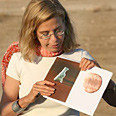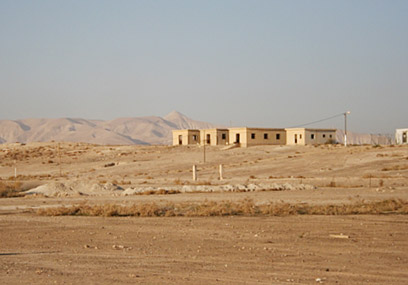
Where's the historical Gilgal?
Responsibility for preservation of site, considered one of oldest in world, is being shifted from one to another. There are also claims of private ownership of this prehistoric land
The shared tour along the Jordan River was held recently to learn more about the condition of the river and the tourism potential of the surrounding areas. The tour was held by members of the “friends of the Earth” organization, and they were joined by municipality and authority leaders from both sides of the river.
As mentioned above, one of the sites visited was Gilgal, a Neolithic site. Dr. Hershman was supposed to speak to the group about its significance. To clarify matters, there is no connection between the site and biblical Gilgal, and it is named after the nearby kibbutz bearing the same name.

Gilgal (Photo: Gili Sofer)
The problem is that an unprofessional viewer would be hard pressed to find anything unusual about the location. The only visible things are ditches, which can look like the work of a bulldozer intended to dig in the earth or to entrench a tank. There isn’t even a sign. The archeological dig is solely surrounded by dirt mounds. There is what was once a Jordanian military post in the opposite hill, and in the background is the location of the Hashmonai fort of Alexandrion.
If these facts regarding the condition of the terrain aren’t enough, one of the local farmers in the area approached the group and informed them that he is the owner of the land, and he has received a permit to build a plant nursery on it.
'Capturing a moment in time'
“The prehistoric settlement, about 11,000 years old, is one of the oldest villages in the world, and one of the most important sites for understanding the beginning of agriculture,” says Hershman. According to her, the site, about an acre in size, was dug about 20 years ago by a team led by the late Dr. Tamar Noy, of the Israel Museum.
The dig unearthed remains of thirteen round buildings made of mud and rock. These buildings contained figurines and other artifacts of worship, as well as agricultural tools: Grinding stones, pounding stones, axes and sickle blades. “The oldest known agricultural tool,” says Hershamn. “ This is among the first places showing human architecture as well.”
The Gilgal site has current significance in addition to its historical importance. “Friends of the Earth” are working on a plan to certify the Jordan Valley area as a world heritage site, and one of the criteria looked at is the area’s unique prehistoric heritage.
In recent years the Israel Museum is making great and international efforts to understand the secrets of the ancient site. Nineteen researchers from five universities are working on the project, headed by Prof. Ofer Bar-Yosef from the Department of Anthropology at Harvard University. A quarter of a million dollars are dedicated to the research.
The most important discovery from the site was a silo found still containing a large amount of grains of wheat and barley. These grains were studies recently by a team of researchers headed by the archeological botany expert Prof. Mordechai Kislev from the department of Israeli studies at Bar Ilan University.
“This study,” says Hershamn, “shows that the grains found in the silo were the first seeds planted by man. It’s unbelievable. It’s like capturing a moment in time. This type of discovery is very rare.”
All the findings from the site are now kept at the Israel Museum. Why is it still important to preserve the place they were taken from? “Most people mistakenly think that when archeological dig at a site, they dig it in its entirety. That is not the case,” Says Hershman. “Most archeologists dig a part of the site. His is partly because of technical reasons, but mostly it is due to the belief that archeological sites should be left to the next generation of researchers.”
This belief, one must add, is not out of fear for the livelihood of researchers to come. Instead, it comes from the understanding that in years to come more information can be collected from these sites than if they were all dug today.
This is why, Hershamn explains, the law requires archeological sites to be fenced in. Signs and protection are also required. “This site isn’t fenced and has no signs, the minimum effort required by law,” she protests. Hershamn has approached the antiquities authority on the matter.
'This site cannot be preserved'
Whatever the consensus may be on the matter, areas of the Jordan Valley seized in 1967 is in the occupied territories, which means that the antiquities there aren’t under the supervision of the antiquities authority.
The person in charge of these antiquities is the chief archeology officer in the IDF’s civil administration, Dr. Yitzhak Magen. Dr. Magen sounds surprised by the allegations: “The museum dug the site, and it is their responsibility to preserve the site,” he tells Ynet.
He also adds that no one visits this prehistoric site. “I don’t know if you can even preserve a prehistoric site. The museum should publish the late Prof. Noy’s findings first, and then make accusations at others.”
Magen also mentions damage created to the site before the dig, when the UDF was there. “As far as I know, according to my inspectors, there is no change in the state of the site.” He also explains that the definition of the site as prehistoric is by the findings in it and not by the buildings as is the case in other sites. “This is not a site you can preserve,” he says, “Prehistory is a problem.”
Magen alleviates any concerns regarding construction. “We, as inspectors, do not approve any construction.” He also notes that he has received no petition from Hershamn on the matter. “She should contact us by letter, and we will take care of it,” He says.










